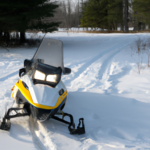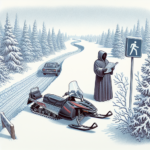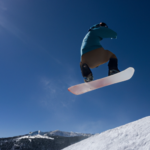Ready to take your ATV for a spin and wondering if snowmobile trails are a viable option? Your curiosity isn’t misplaced, but there’s more to it than just blazing down those snowy paths. In the article “Can You Ride ATVs on Snowmobile Trails?”, you’ll find all the answers, which unfold a multitude of factors, from legal restrictions to safety concerns and even environmental implications. It’s the definitive guide to understand the do’s and don’ts about riding ATVs on snowmobile trails. So gear up, because this exploration is going to be quite a ride.
Overview of Snowmobile Trails
What are snowmobile trails
Just like the name implies, snowmobile trails are specifically designed and maintained for snowmobiles. These are tracks that are laid out over snow-covered land, typically during the winter months. The trails often meander through forested lands and across frozen bodies of waters, providing an adventurous outdoor experience.
Unique characteristics of snowmobile trails
Snowmobile trails are not your regular dirt trails. They are generally groomed by clubs and organizations to maintain a smooth, compact snow surface. They often feature a variety of terrains, ranging from flat, open fields to hilly, winding paths. Signage is a common feature found along these trails, offering riders direction and safety information.
Where can you find snowmobile trails
Snowmobile trails are usually found in colder climates where there’s ample snowfall. Regions like northern parts of US and Canada, Scandinavia, and other places with long, snowy winters commonly have these trails. They’re often available in state and national parks and many ski resorts also offer snowmobile trails.
Typical activities on snowmobile trails
Snowmobile trails are primarily used for recreation. Riders take their machines out on these paths for a thrilling ride through snowy landscapes. They’re also sometimes used for practical modes of transportation in snow-heavy regions. Additionally, many places hold snowmobile races and other events, turning these winter trails into a gathering spot for enthusiasts.
Understanding ATVs
Definition of an ATV
An ATV, or All-Terrain Vehicle, is a type of vehicle that can traverse various types of terrain, as it is designed for off-road usages. These vehicles typically have four wheels, a straddle seating position, and handlebar steering.
Features and capabilities of ATVs
ATVs can handle a variety of terrains, hence the name. Because of their sturdy construction and powerful engines, they can climb steep hills, navigate muddy areas, and cross shallow streams. They are usually equipped with chunky, deep-tread tires, powerful engines, and a comfortable seat for the driver.
Typical uses for ATVs
ATVs are versatile, and can be used for a variety of purposes. Many use them for outdoor adventure and recreational purposes such as hunting or trail riding. They are also commonly used in farms and ranches for transportation or for hauling small loads.
Appropriate terrains for ATVs
ATVs are designed to handle many types of terrains—ranging from muddy forests to sandy deserts. However, they are not as suited for snow unless equipped with the proper modifications. Because of the unique demands of snow, it can be challenging for ATVs to maintain traction on snow-covered surfaces without these modifications.
ATVs versus Snowmobiles
Similarities and Differences
Both ATVs and snowmobiles provide fun and excitement for outdoor enthusiasts. They share some similarities, like offering exciting speeds and handling off-road terrains. However, they’re distinctly different. Snowmobiles are designed for snow and cold conditions. ATVs, on the other hand, are versatile for all seasons and terrains—but they require modifications when it comes to snow.
Benefits of ATVs over Snowmobiles
One of the biggest benefits of ATVs over snowmobiles is their all-around usage. You can use an ATV in virtually any season, not just in winter. They’re more versatile, and can be effectively used on dry or wet ground, muddy areas, or sandy terrains. Additionally, ATVs usually have storage space—a feature not as commonly found on a snowmobile.
Benefits of Snowmobiles over ATVs
Snowmobiles, on the other hand, shine brightest when there’s snow around. They’re specifically designed to glide through snowy and icy terrains. This makes them superior to ATVs in such conditions, as they have better handling, balance, and control in the snow. Riding a snowmobile can provide an exhilarating winter adventure, something an ATV may not offer in the same measure.
Why People Would Want to Ride ATVs on Snowmobile Trails
The appeal of snowmobile trails
Riding ATVs on snowmobile trails can infuse a new level of thrill to ATV riding, thanks to the unique characteristics and challenges these trails offer. The snow-covered landscapes, the soft crunch of the snow beneath the tires, and the fresh winter air can be highly appealing.
The versatility of ATVs
The versatility of ATVs makes them a good choice to explore these trails. With the right modifications, an ATV can offer as much fun, if not more, as a snowmobile on a winter trail.
Challenges of using other trails
Snow-covered terrains can be a real challenge for ATVs, but this very challenge can be part of the appeal. Unlike regular trails, snowmobile trails would require strategic planning and added skills from the riders, adding more excitement to the ride.
Legal Considerations for Riding ATVs on Snowmobile Trails
Overall legality of using ATVs on snowmobile trails
Whether or not an ATV can be ridden on snowmobile trails depends on local laws and regulations. Some places expressly prohibit the use of any vehicles other than snowmobiles on designated snowmobile trails.
Variances in laws between regions/countries
Laws can vary greatly from one region to another, or even within regions. Some places might allow ATVs on snowmobile trails, especially if they’re properly equipped, while others might not. It’s always essential to check local laws and regulations before riding an ATV on a snowmobile trail.
Penalties for illegal usage of ATVs on snowmobile trails
Using an ATV on a snowmobile trail where it’s not allowed can lead to punishments including fines or confiscation of the vehicle. It could also result in the trail getting closed, affecting other riders. Therefore, knowing the laws and adhering to them is crucial.
Safety Considerations for Riding ATVs on Snowmobile Trails
Potential safety concerns
Riding an ATV on a snowmobile trail can present some unique safety challenges. The icy conditions can make handling tricky, and the cold weather can pose health risks. Other trail users, like snowmobile riders, may not expect an ATV out on the trails, leading to potential accidents.
Tips for safe usage of ATVs on snowmobile trails
Observing safety precautions is essential when riding an ATV on snowmobile trails. Always wear appropriate gear, including a helmet, goggles, and winter clothing. Keep your speed under control, especially in low visibility or in corners. And always ride with caution, being aware of other users on the trail.
Recommended safety gear for ATVers on snowmobile trails
It’s crucial to have major safety gear when going out on an ATV on snowmobile trails. A quality helmet to protect your head, goggles to shield your eyes from flying snow and ice, and insulated clothing to keep you warm are all must-haves. Specialized winter tires or tracks could also be beneficial to maintain traction on icy trails.
Impact on The Environment
Potential environmental effects of ATVs on snowmobile trails
ATVs, like any other motorized vehicle, could have an environmental impact. If the trails aren’t frozen enough, ATVs could damage the trail surface and vegetation beneath. They could also potentially disrupt wildlife, particularly if they veer off the trail.
How to minimize environmental impact
To minimize environmental impact, stay on the trail and avoid sensitive areas. Make sure your ATV is properly maintained to prevent any leakage of harmful substances. Try to minimize noise when possible, especially in areas with wildlife.
Comparison of environmental impact of ATVs vs. snowmobiles
ATVs can be heavier on the environment than snowmobiles, primarily because they can be used throughout the year, not just during snow seasons. Also, snowmobiles devoid of studded tracks are generally gentler on trail surfaces because they glide over the snow, causing less ground disturbance. Therefore, riders should always ensure they’re doing their part to minimize environmental impacts no matter which vehicle they choose.
Modifications Needed for ATVs on Snowmobile Trails
Types of ATV modifications for snow use
As ATVs are not initially designed for snow use, they may need some modifications to handle snowmobile trails. These modifications include installing snow tracks instead of wheels, installing a windshield to protect against wind and snow spray, and setting up hand and thumb warmers for added comfort in the freezing cold.
How to install these modifications
As the modification process can be complicated, it might be best done by ATV experts or professionals, especially if it involves installing snow tracks. However, some simpler modifications, like installing a windshield, can be done using an ATV modification kit and following the manufacturer’s instructions.
Potential costs of these modifications
The cost of ATV modifications for snow use can vary widely, depending on the type of modification. Simple modifications like windshields could be relatively inexpensive while others like snow tracks can be costly due to the expertise and specialized equipment required.
Places Where You Can Legally Ride your ATVs on Snowmobile Trails
List of ATV-friendly places
As laws vary by region, countries, it’s essential to find specific places where riding an ATV on snowmobile trails is legal. Reliable resources could be local outdoors or ATV enthusiast groups, regional natural resource departments or appropriate online forums.
Characteristics of these places
ATV-friendly places often have clear signage indicating where ATVs can and cannot be ridden. There may also be specific rules about the types of ATV modifications required for snow use.
Rules and regulations in these places
As with any outdoor recreational activities, there are rules to adhere to. These rules might include operating the ATV within a certain speed limit, only riding during certain hours, and sticking strictly to designated trails. Knowing and adhering to these rules is part of being a responsible ATV rider.
ATV and Snowmobile Trail Etiquette
Understanding trail etiquette
Just like we have rules of the road, there’s trail etiquette to observe. This includes yielding to others on the trail, particularly those on foot or on smaller vehicles.
Examples of good etiquette when using ATVs on snowmobile trails
Some examples of good trail etiquette include riding on the right side of the trail, slowing down when passing others, and not disturbing wildlife. As an ATV rider on a snowmobile trail, be conscious about the noise your vehicle makes and try not to cause excess trail damage.
The importance of respecting snowmobile trail users
Respecting others on the trail is critical, especially when riding an ATV on a snowmobile trail where you might be unexpected. Respect is key to maintaining a shared use of these outdoor spaces, and ensuring a positive experience for all.
- What Snowboard Bindings Should I Get? - January 23, 2024
- What Size Screws For Snowboard Bindings? - January 23, 2024
- How To Snowmobile On Water? - January 23, 2024










